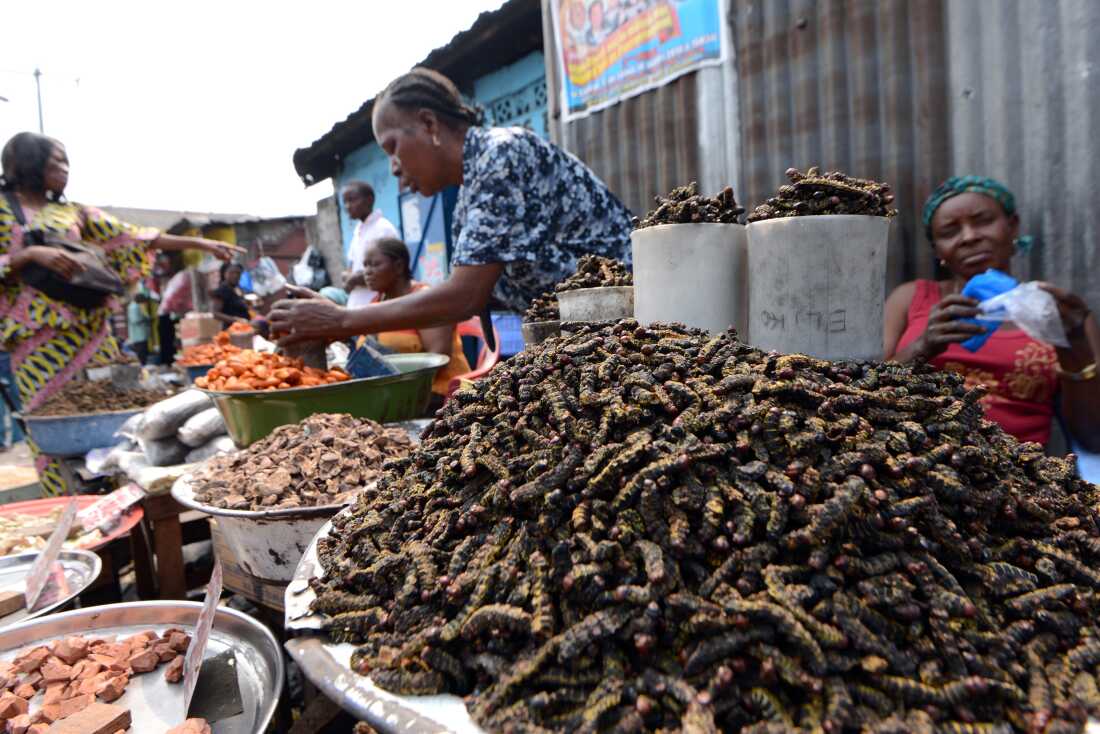A vendor holds huge weevil larvae at Kinshasa’s Gambela market. At Gambela market, folks can discover bugs for all tastes : huge weevil larvae leaving a smoothness feeling within the mouth, barely crunchy caterpillars or termites cracking between your tooth
Junior D. Kanna/AFP through Getty Photographs
conceal caption
toggle caption
Junior D. Kanna/AFP through Getty Photographs
KINSHASA, Democratic Republic of Congo — They’re tastier than they appear. Edible bugs within the type of wriggling maggots or furry caterpillars are each delicacy and staple within the Democratic Republic of Congo (DRC), a central African nation of almost 120 million folks.
In markets within the capital Kinshasa, tubs stuffed with writhing white maggots line the alleyways, and ladies merchants fry caterpillars, spiced with chili, over charcoal fires. “The extra you eat caterpillars, the extra you may have an extended life,” says Trésor Kisanbu, clutching a small plastic bag of fried caterpillars, in Kinshasa’s largest market, Marché Liberté. “It strengthens your muscle groups and your eyes, it is actually natural,” he provides.
Villagers harvest recent caterpillars and maggots from rotting tree trunks in forested areas within the Congolese inside. From there, they’re despatched by the boatload down the Congo River — the second-largest in Africa — on the market in Kinshasa’s markets.
“Folks eat a whole lot of them,” says Mamman Coco, who runs a stall overflowing with piles of maize flour, dried beans and edible bugs, within the middle of Kinshasa’s sprawling central market.
She factors to the caterpillars’ excessive protein and vitamin content material as promoting factors, and the truth that they’re natural.

Crunchy caterpillars on sale in a market in Kinshasa.
JUNIOR D. KANNAH/AFP
conceal caption
toggle caption
JUNIOR D. KANNAH/AFP
To style, the caterpillars are earthy and bitter. Generally known as Mbinzo, in Kinshasa’s dominant language Lingala, the caterpillars are from a species of emperor moth.
They’re an costly delicacy at about $200 a kilo, an infinite sum in a grindingly poor nation the place, in response to the World Financial institution, two thirds of the inhabitants survive on beneath $2 a day.
Mpose is extra common fare. That is the Lingala time period for the larvae of palm weevils, a sort of beetle that lives in palm bushes. They are often eaten with rice or fufu, a starchy staple, or as a crispy fried snack.
The larvae are principally imported from rural areas too, however they are often raised commercially.
Congolese NGO Farms For Orphans raises Mpose maggots by the hundreds to distribute to orphanages in Kinshasa, nevertheless it additionally sells its produce to market merchants and Congolese émigrés nostalgic for a style of house.
“Within the DRC, meat merchandise aren’t obtainable to everybody,” explains Françoise Lukadi, the president of Farms for Orphans, due to their excessive value. “For those who purchase very small portions of bugs, you acquire extra dietary worth than if you happen to purchase the identical portions of meat,” she says.
Consuming bugs is conventional in lots of elements of Congo. Nevertheless, the observe is not frequent in all elements of the nation. An enormous state roughly the scale of continental western Europe, Congo is very numerous, with over 200 completely different ethnic teams and as many spoken languages.

An individual eats grilled caterpillars with olive oil in a makeshift restaurant within the Lingwala district of Kinshasa.
JUNIOR D. KANNAH/AFP
conceal caption
toggle caption
JUNIOR D. KANNAH/AFP
Some analysis means that insect consumption has elevated in current many years. A 2023 research printed within the journal Bois et Forêts des Tropiques discovered that within the Luki biosphere reserve about 250 miles southwest of Kinshasa, in western Congo, villagers solely started to eat bugs within the late Nineteen Seventies.
Based on the lead researcher Ernestine Lonpi Tipi, that interval coincided with drought and the gradual degradation of forests, and subsequent shortage of bushmeat. Then, back-to-back civil wars within the Nineties and 2000s cratered the financial system.
Lonpi Tipi added that domesticating larvae manufacturing in the end would result in fixing issues associated to entry to protein- and nutrition-rich meals.
Françoise Lukadi of Farms for Orphans agrees. In a low rectangular constructing in Kinshasa’s essential college, cabinets are stacked with plastic tubs of palm weevils. Employees clear out the tubs and add in new meals for the maggots: items of palm bark and natural waste from beer manufacturing.
Farms for Orphans produces about 300 kilos of maggots a month and it is seeking to broaden manufacturing.
“They’re excellent to eat,” Lukadi mentioned, however she admitted that even in Congo, the place folks eat bugs usually, many are nonetheless squeamish.









